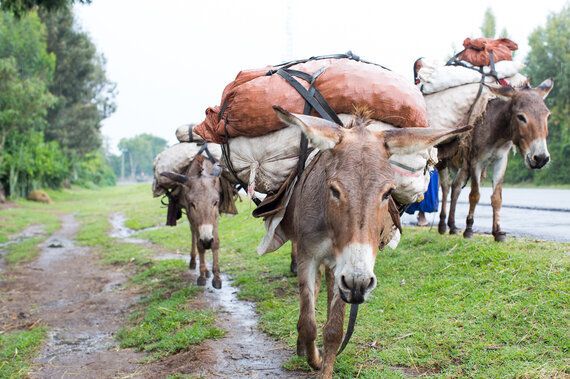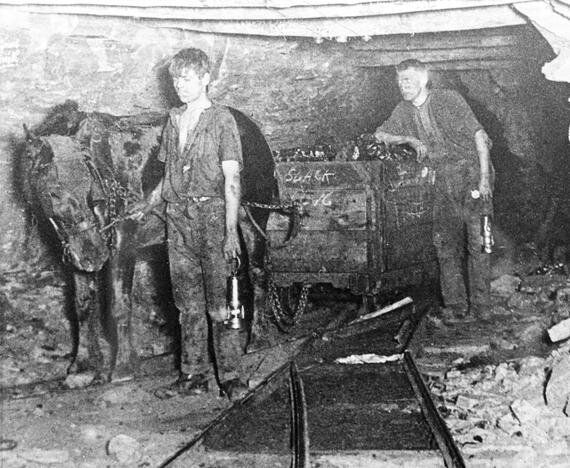
(Photo credit: SPANA)
For thousands of years, working animals were our main source of power in Britain. Their 'horsepower' was the driving force of agriculture, transport, mining and warfare.
From plough horses and oxen, to cart horses, pit ponies and war horses, these animals were the engines that transformed our economy and the lives of people across all sections of society.
Working animals were ubiquitous in every corner of Britain - as commonplace as the automobile today - hauling, carrying, transporting, and powering every aspect of daily life.
Over the course of the twentieth century, these animals were gradually replaced by mechanised vehicles, such as cars, buses, tractors and trains. But their contribution to building Britain is unequivocal. And, in developing countries around the world, working animals (otherwise referred to as beasts of burden or draught animals) continue to perform a fundamental role as they once did here.
It's a sad reality that, today, the historic and indispensable partnership between working animals and people in Britain is a distant memory. Research shows that 40 per cent of people in UK now don't know what a working animal is. For younger people, raised in an age of rapid technological development, the concept of a working animal is even more alien - and virtually half of 18 to 24 year olds (49%) are unfamiliar with the term.
Most people over the age of 60 will remember the regular visits made by the rag and bone man, collecting refuse by horse and cart - a familiar sight across the country in the 1950s, and into the 1960s. Door-to-door deliveries of milk and coal were also still commonly made by horse and cart in the post-war era.
Even so, it's hard to believe that, back in 1900, almost every vehicle on London's streets was horse-drawn and around 300,000 horses were used to pull carriages, cabs, buses, trams and delivery vans. By transporting goods and people, this huge animal workforce kept the world's busiest city on the move and was key to our prosperity.

(Whitehall/Photo credit: SPANA)
The presence of such a large animal population was not without its problems. In 1894, London faced The Great Manure Crisis - unsurprising when you consider that each horse produced up to 35 pounds of manure on a daily basis. The volume of manure on London's streets attracted huge numbers of flies, which then spread typhoid fever and other diseases. The crisis led The Times newspaper to predict that "In 50 years, every street in London will be buried under nine feet of manure."
Their forecast did not come to fruition. Few would have predicted it at the time, but 20 years later horse buses and trams had disappeared in London, and motor taxis outnumbered horse-drawn cabs by 1915.
Once a familiar sight in streets, fields and factories throughout the country, working animals in Britain were gradually replaced due to mechanisation. Speed was a deciding factor in this process. Prior to steam railways, when galloping horses were the fastest things on earth, it's no surprise that they were used to deliver our goods and mail. For the same reason, Britain became the first country to replace horses with tractors (as horses had earlier replaced working oxen in agriculture).
By the mid-1930s, there were 2.5 million cars in Britain, whereas 20 years earlier there were fewer than 15,000. The perceived status and increased affordability of vehicle ownership pushed the horse further back into history.
But, despite the coming of motorised vehicles, working animals did not vanish overnight and they maintained a prominent position for decades to come. London Fire Brigade was using horse-drawn fire engines up to 1921. More than 11,000 horses continued to be used on Britain's railways in 1940 (the last British Railways horse wasn't retired until 1967), and in 1942 horses outnumbered tractors on British farms by 30 to 1 (the reversal didn't take place until the 1950s). Perhaps most astonishing is the fact that pit ponies were still working underground in British coal mines as late as 1999.

(Photo credit: SPANA)
In Britain, working animals are now effectively consigned to history. But, many people have a fond place in their hearts for shire horses and other breeds, and rightly so. We should certainly acknowledge our debt to these animals and the enormous contribution they made to our history through their tireless hard work.
In the twenty-first century, working animals endure as the linchpin of economies in the developing world. Today, one billion people depend on working horses, donkeys, mules, camels, oxen and elephants for their livelihoods. There are an estimated 200 million working animals worldwide and, by transporting goods, water, food and people, these animals help the poorest families to earn a small income. One working animal alone can be responsible for supporting an extended family of up to 30 people.
Sadly, for many working animals, life can be short, brutal and painful. They often work long hours in harsh climates, dehydrated, overloaded and malnourished. Like their owners, they will never get to enjoy rest or retirement. In most cases, they have no access to veterinary treatment when they are sick or injured, or their owners simply can't afford to pay for it.
SPANA works to improve the lives of working animals, and the communities that rely on them, around the world. The charity delivers free veterinary care to working animals, as well as providing education and training for communities in how to better look after their animals.
But, there are still millions of animals that desperately need our help, and their vital role is largely unknown and ignored.
On International Working Animal Day (15 June), we're asking everyone to show their support for these hardworking animals. It's time that governments and international aid organisations recognised their importance and helped ensure they get the treatment, respect and compassion they deserve.
For more information, visit www.spana.org/IWAD